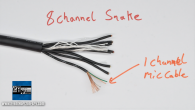I would like to introduce our informative video: Wire Types – Part 2
Here are some details from the video:
Digital AES/EBU and DMX wire:
Digital audio cable for AES3 or AES/EBU is similar to mic cable.
It is a twisted pair shielded cable and has a characteristic impedance of 110 ohms.
Because it uses a twisted pair in a balanced configuration, it can transmit data over long distances.
It carries a digital audio signal connecting gear or interfaces and normally carries two channels of audio.
AES cables are normally found with XLR connectors but can have euro connectors too.
DMX cables are identical to AES cable, except they should have a 120-ohm characteristic impedance.
Most of the time, AES wire is used for DMX lighting applications because it is within the DMX spec’s tolerance.
You can use AES or DMX cable for analog audio, but you should not use an analog cable for AES or DMX.
Coax wires:
Coax cable, as I said, consists of a center conductor that is surrounded by a shield.
They normally have multiple shields layered together. This is as much to keep the signal in as it is to keep noise out.
The common forms of these cables will have a characteristic impedance of 50 or 75 ohms.
Common applications include SPDIF, which is Digital audio, SDI, and HDSDI, which is Digital video, Composite video, component video, and clock for audio converter syncing, Cable TV, antennas, and more.
Common connectors are BNC, F-type, and RCA.
CAT Wire:
CAT cable is also commonly called Ethernet cable or network cable and consists of CAT5, CAT5E, CAT6, CAT6A, CAT7, and more.
In the basic form, it is normally 4 pair unshielded cable. So it has 8 conductors in pairs of two.
It comes in many varieties, with shield, and without shield, with spacers, and without spacers, individually shielded and not, and more.
The main thing to know is that normally the higher the number, the higher the bandwidth rating. Meaning the higher the number, the more data it can transmit.
Normally these cables are terminated with RJ-45 connectors.
Sometimes you will find applications where CAT cables will be carrying analog audio.
Snake Wire:
The basic definition of snake cable is a cable with multiple cables all built into one.
The most common form of this is the audio snake, where it can have 2, 4, 8, 12, 16, 24, etc. number of channels.
In that audio snake are multiple mic cables or single pair shielded cables. Each cable is independent and can carry its own signal.
Snakes come in many, forms from containing all audio cables to all video cables to audio and video cables, video and CAT5 cables, etc.

